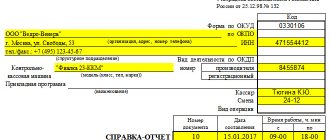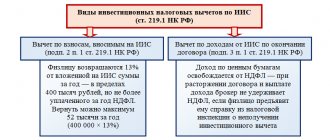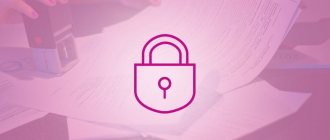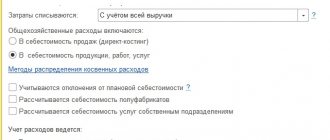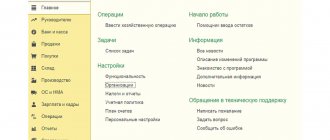The cash receipt is familiar to every modern person. This document is issued by cashiers in supermarkets and stores, as well as other organizations involved in the sale of goods. Many entrepreneurs who decide to open an individual entrepreneur wonder about the need to install cash register equipment at the very last moment. And completely in vain.
Cash register equipment must be used every time a customer pays in cash. At the same time, failure to issue, as well as failure to punch through, cash receipts is a very common violation that is detected during audits by tax authorities.
Why do you need a cashier's check?
A cash receipt, first of all, is confirmation of a completed transaction. When this document is entered, the amount of funds transferred through the cash register during the reporting period is recorded. If a transaction is made “bypassing the cash register,” then this is a direct violation of the client’s rights, and also goes against the concept of cash discipline.
The check contains information such as:
- name of the individual entrepreneur;
- TIN of the individual entrepreneur;
- transaction amount;
- date and time;
- number of the check, cash register and electronic document;
- serial number of the PDA;
- PDA.
In some cases, the name and quantity of the purchased product is printed on the cash register receipt.
Contrary to popular belief among unscrupulous sellers, a blank cash receipt or the issuance of an alternative (sales receipt) does not deprive the client of the opportunity to return money for the purchased product. Therefore, such a “trick” can only result in additional problems, a fine and unwanted attention from the tax service.
It should be noted that the inspection authorities are very attentive to the issue of issuing cash receipts. If they have suspicions, they take the entrepreneur, as they say, “on a pencil” and show more zeal during inspections, which greatly increases the chances of getting a fine for some minor deviation from strict rules.
PKO: to issue or not to issue?
Many individual entrepreneurs work under special regimes, in particular under the simplified tax system. The use of the simplified tax system, on the one hand, involves conducting cash transactions in the prescribed manner, on the basis of the Central Bank Directive No. 3210-U dated March 11, 2014.
Accepting cash through a cash register and processing cash transactions through a company's cash desk are not the same thing. A cash register is not a company's cash register. The main cash register stores all the company's cash (within the limit set by the bank), and the cash register cash drawer stores the proceeds from the sale of goods for the day. At the end of each day, the proceeds are handed over to the main cash desk of the enterprise and documented with the appropriate accounting documents.
Read in the berator “Practical Encyclopedia of an Accountant”
What does it mean to conduct cash transactions?
So, to register the receipt of cash at the cash desk, there is a cash document called a cash receipt order - PKO. This is form No. KO-1, which was approved by Rosstat Resolution No. 88 dated August 18, 1998.
On the other hand, Directive No. 3210-U allows individual entrepreneurs who keep records of income and expenses that characterize a certain type of business activity to apply a simplified procedure for conducting cash transactions. This procedure means that cash documents, in particular, cash receipts and debit orders, may not be executed (subclause 4.1, clause 4 of Directive No. 3210-U).
At the same time, paragraph 5 of Directive No. 3210-U does not prohibit them from drawing up these documents. With them, keeping records of funds and income is much more convenient and more consistent with the requirements of the Tax Code of the Russian Federation.
Why?
PKO refers to primary accounting documents (subclause 4.1, clause 4, clause 5 of Directive No. 3210-U).
Taxpayers using the simplified tax system are required to keep records of income and expenses in the accounting book (KUDiR) (Article 346.24 of the Tax Code of the Russian Federation). The form and procedure for filling it out are approved by order
Ministry of Finance dated October 22, 2012 No. 135n. And income taken into account when calculating the tax base is reflected in the KUDiR on the basis of primary documents.
Read in the berator “Practical Encyclopedia of an Accountant”
How to fill out KUDiR
Non-issuance of checks and consequences
The current legislation provides for liability in the form of a fine for a cash receipt that is not punched or issued. It should be noted that this rule also applies to any other documents issued using cash register equipment that has not been registered or does not meet the requirements.
If an official discovers that a cash receipt has not been issued, a fine of three to four thousand rubles will be imposed. Legal entities in a similar situation will have to fork out ten times more.
In some cases, a fine can be replaced with a warning, but only if two conditions are met:
- Until this moment, the individual entrepreneur has not committed any administrative offenses;
- During the inspection process, tax inspectors did not identify any other violations.
In other words, an individual entrepreneur can avoid a fine for failure to issue a check only once during the entire period of work.
Failure to issue a cash receipt is detected only during an inspection of individual entrepreneurs or legal entities by tax officials. However, it should immediately be noted that customer complaints can serve as a reason for an individual entrepreneur’s inspection. Repeated violations of cash discipline sooner or later attract close attention from the relevant government agencies, which ultimately turns into big troubles. And if the amount of the fine may seem completely insignificant to many entrepreneurs, then the alternative in the form of excessive attention from the inspection authorities will cause much more trouble and headaches.
Fine for failure to clear a cash receipt and other similar offenses
The fine that a company faces if a check is found to be unbroken, in accordance with clause 6 of Art. 14.5 of the Code of Administrative Offenses of the Russian Federation, can reach up to 10,000 rubles. For an individual entrepreneur or an official, this will cost up to 2,000 rubles. True, if you're lucky, violators can get off with a warning.
However, the absence of cash register receipts is not the only violation that entails sanctions. For example, failure to use cash registers threatens the enterprise with a fine in the amount of ¾ to the entire amount of unrecorded revenue, but not less than 30,000 rubles. For a director or individual entrepreneur, other amounts are provided - from a quarter to half of the proceeds, but not less than 10,000 rubles. (clause 2 of article 14.5 of the Code of Administrative Offenses of the Russian Federation).
Repeated detection of the same violation (if the hidden revenue reaches 1 million rubles) threatens with disqualification of officials for a period of 1 to 2 years, suspension of the activities of the enterprise or individual entrepreneur for up to 90 days.
IMPORTANT! According to Art. 2.4 of the Code of Administrative Offenses of the Russian Federation, entrepreneurs bear exactly the same administrative responsibility as officials (unless the Code of Administrative Offenses prescribes otherwise). At the same time, Art. 14.5 of the Code of Administrative Offenses does not contain any clauses protecting individual entrepreneurs.
Read about other nuances of maintaining cash discipline in the material “ Cash discipline and responsibility for its violation .
When the CCP is faulty
Any equipment has the unpleasant property of breaking and failing. And cash registers are no exception. Failure to issue a receipt may be due to either technical reasons or the fact that the device simply runs out of tape. In any case, the position of the law remains clear: a check is mandatory and must be issued, no check - no sale. Otherwise, a technical malfunction is equated to a deliberate violation of laws and is punishable by a fine.
According to the rules, in the event of a malfunction of the cash register, the seller must stop accepting cash and cancel the transaction if it had already begun at the time of the malfunction. If the device simply runs out of tape, then it is permissible to replace it and continue your work. Otherwise, a fine may be imposed on the entrepreneur.
Who can work without a cash register
It turns out that not all entities are required to use cash register equipment. There are organizations and entrepreneurs that are either exempt from this need or have received a deferment. Thus, the following types of business entities can be classified as persons who received the opportunity to defer until 2022.
Organizations operating on the basis of OSNO and simplified tax system, patents, which (in accordance with the provisions of Article 346.43 of the Tax Code of the Russian Federation):
- repair and sew leather goods, fittings and accessories;
- service shoes;
- provide beauty salon services;
- carry out dry cleaning and painting;
- produce haberdashery goods;
- provide motor transport services;
- repair all kinds of buildings;
- glaze household items.
Check forgery
There can be many reasons for counterfeiting cash receipts. Some companies and individual entrepreneurs commit such an offense in order to reduce taxes; buyers do this in order, for example, to get past security in a supermarket by presenting a document prepared in advance. In any case, the counterfeit will sooner or later be recognized and entail undesirable problems described in Federal Law N54.
It should be noted that counterfeiting checks is complicated by the fact that on each document a PDA code is printed, which is generated by the EKLZ from data such as amount, date, time and check number. Even with a very strong desire, it is almost impossible to decipher such a combination of symbols on your own, and even more so to generate it manually.
Moreover, in each tax office building there is a special box where anyone can place a cash receipt for verification. Employees of this institution periodically check the contents of the box for compliance with the PDA code. Moreover, you can check the authenticity of cash receipts yourself. To do this, you don’t have to leave your home at all; you just need to fill out a special form on the official website of the tax office. If a forgery is discovered, the organization that issued the fake document will face an unscheduled inspection.
Amendments to the laws of cash management for individual entrepreneurs
The modernization of the current legislation on the commercial activities of individual entrepreneurs began a long time ago. The modernization program itself was launched in 2022.
First of all, government agencies are trying to simplify the process of registering cash registers. For this purpose, the reporting is being converted into electronic form. When online cash registers are introduced as mandatory for all entrepreneurs, a report on each transaction will be automatically sent to the tax office via the Internet.
Soon, the buyer will be able to request a duplicate electronic version of the check for the money paid, which will be sent to him by email. This initiative aims to simplify warranty return procedures.
It is believed, but there is no legislative confirmation yet, that equipping with cash register equipment will become mandatory for all entrepreneurs, regardless of the type of activity or the taxation system.
When can you do without a check?
According to the current legislation and Federal Law No. 54 of May 22, 2003, in particular, individual entrepreneurs have the right to refuse to use cash register equipment in a number of cases:
- If the activities of an individual entrepreneur are related to the provision of services to the public. In this case, strict reporting forms are issued, which act as an alternative to cash receipts;
- Use of certain taxation schemes. An individual entrepreneur may not issue a cash receipt on completely legal grounds if PSN or UTII is used. This exception includes the types of activities provided for in paragraph two of Article 346.26 of the Tax Code of Russia. However, the issuance of an alternative in the form of a sales receipt, receipt or any other document confirming the receipt of cash is mandatory.
Otherwise, failure to use the cash register is illegal.
It should be noted that a cash receipt cannot be replaced by another document, with the rare exceptions noted above. If, instead of a cash register, the client receives a sales receipt, invoice or any other paper, he will have the right to send a complaint to the appropriate authorities.
Previous article: How an individual entrepreneur can close a bank account Next article: Work experience of an individual entrepreneur in the light of the new pension reform
Is the seller required to provide a receipt document upon purchase?
The requirement to issue cash register receipts to customers and clients is enshrined in the Federal Law of May 22, 2003 No. 54-FZ “On the use of cash register equipment (CCT) when making cash payments and (or) payments using payment cards.”
Issuing a check is considered the seller's responsibility and otherwise is punishable by administrative liability . Control over compliance with cash discipline is carried out by the inspection of the Federal Tax Service and Rospotrebnadzor.
Bottom line
At the moment, those individual entrepreneurs who operate under preferential taxation systems themselves choose between cash registers and documents replacing checks.
Whether you, as an entrepreneur, can choose the option of conducting business without a cash register depends on the taxation system and the specifics of the activity itself.
In the future, measures and amendments to laws will be taken aimed at obliging every entrepreneur to equip their reporting activities with modernized cash register systems capable of transmitting data about each procedure to the tax service online.
Changes in CCP requirements
Cash register equipment will be replaced. Instead of an electronic tape, a drive should be used, from which information will be transmitted online to the Federal Tax Service. And in the absence of a report on transactions from the company, tax authorities will be able to assign audit measures in relation to the activities of the entrepreneur as soon as possible.
The goal of systemic and global changes is to obtain a more open and transparent picture of the activities of each company and simplify reporting for them. But this is ideal. Only time will tell how the control system will operate in reality.
How to create and send checks correctly
Self-employed people often have problems with checks, although the process of creating them is as simple as possible. You will need information from the counterparty and a few minutes to fill out the form. Technical problems rarely occur, so in most cases there will be no problems.
Check generation process:
- The client pays for a service or product.
- The self-employed person asks him for details to create a check.
- A self-employed person opens the “My Tax” application, enters the details and receives a ready-made check.
- Sends the document to the client in any way.
If a self-employed person receives money from foreign customers into a foreign currency account, he must transfer the amount in dollars, euros or other currencies into rubles at the rate of the Central Bank of the Russian Federation on the day of receipt. For example, if a customer transferred $100 on April 22, but the self-employed person wrote a check only on April 30, the amount must be recalculated at the exchange rate of a week ago.
Self-employed people who perform in-home services or visit clients can print paper checks themselves. Any Bluetooth printer will do this. If you don’t have a printing device with you, show the client the QR code from the receipt and he will be able to receive an electronic version of the document.
There are several ways to transfer a check to a counterparty:
- by e-mail;
- to messengers;
- in the form of a screenshot with a QR code;
- in paper form.
Legislative acts indicate that the NPD payer must hand over the check to the client, but it will not be possible to verify the fact of delivery. For example, if you send a file in a messenger, the interlocutor may not enter the dialogue for months. Then it turns out that he did not see the document.
Representatives of the tax office provided clarification on this matter and explained that tax payers have nothing to worry about. They need to send the check to the client in any available way, and at this point their obligations to the counterparty are considered fulfilled.
You can generate a check in the “My Tax” application or partner services from Sberbank and other large IT companies. For example, self-employed clients of Tinkoff Bank can use their personal account to generate checks. They are automatically transferred to the tax office.
As for deducting expenses, the self-employed have no advantages in this regard. You have to pay 4% or 6% on turnover, which is considered income. For example, if you spend 20 thousand rubles on purchasing materials for creating jewelry, and earn 60 thousand a month, you will not be able to deduct expenses.
A check is created for the entire amount that the client transferred to a bank account or an electronic payment system wallet. The expenses of a self-employed person can be at least 50% of income, but this will not affect the calculation of taxes.
The process of creating a receipt in the My Tax application:
- Add a new sale in your personal account.
- Enter the name of the product or service and the price.
- Enter buyer details.
- Click the "Issue Check" button.
- Send the document to the buyer.
If you provide services or sell goods to an individual, the number of fields filled in will be minimal. In the case of legal entities, additional data will be needed: TIN and company name.
Required details on the check:
- document's name;
- Date of sale;
- Full name of the buyer or company name;
- TIN of the self-employed;
- name of the service or product;
- transaction amount;
- QR code;
- name of the intermediary service that created the check;
- unique check number.
If a self-employed person combines individual entrepreneurs and self-employment, he does not need to use an online cash register for transactions that he carries out in the status of an NAP payer. When providing services to clients as individual entrepreneurs, the obligation to use cash register equipment remains.
When combining an individual entrepreneur with self-employment, you can keep the cash register or sell it, but before that deregister it with the tax authorities. When choosing the second option, make sure that the data from the online cash register has been transferred to the tax service and will be stored for at least 5 years from the moment the equipment is deregistered.
There is nothing complicated about working with checks. New self-employed people may experience technical hiccups, but with experience, the process of generating payment documents will occur almost automatically.
If necessary, you can set up integration with the My Tax application through third-party services and ensure that data is transferred to the database without manual intervention. There are solutions on the market that partially solve the problem, but no one bothers you to create your own tools with the help of programmers.
